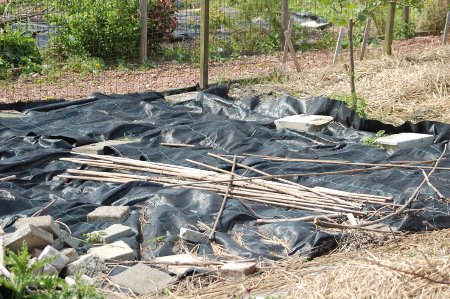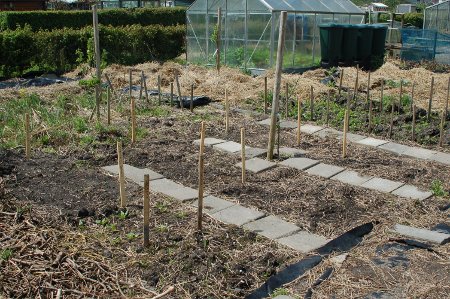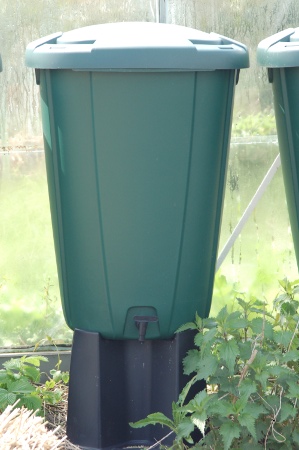I posted the other day about how I prepare my garden beds, and I’ve since had a chance to take some pictures. I want to emphasize I’m not necessarily saying this is the best way for everyone, but it’s the system I’ve come up with after gardening in the Netherlands for about 10 years now. As much as possible it makes use of locally available, reusable and recycled materials, and it takes into account local conditions. It should give you something to think about when you plan your own garden.
When a part of my garden becomes disused, especially at the end of the year, I cover it with plastic sheet mulch or what’s called here ground cloth. I think in the US it’s called landscape fabric. I cut it into 2 x 2 meter squares, which is a convenient size to handle, but also lets me cover large areas quickly. These need to be weighted down, and also constitute unused space, so tend to collect junk. Here you see some unused bamboo poles and extra pieces of concrete.
The paving slabs I use to weight down the corners are what the city of Amsterdam uses to make sidewalks. Every few years these get replaced, and the city disposes of the old stones. If you’re in the right place at the right time, you can just fill up your car with them.
Some people might turn up their nose a bit at the idea of using plastic in their garden, and it certainly works well to use biodegradable material like cardboard or newspaper, then leave it in place and plant over it. For me I use a lot of sheet mulch and I have to carry everything first in my car, then a long distance by foot. I really need to use something reusable instead of biodegradable.
I’ve bought my ground cloth at different times, but some of what I have is 8 years old and still in excellent condition. I tried a cheaper quality ground cloth, which in my case had orange lines instead of green, and that didn’t work well. It was too cheap and fell apart after a year or two. It fell apart in a very unfriendly way, leaving little strands of plastic all over my garden. If you use ground cloth, make sure to get the higher quality material.
I cover different parts of my garden for different times, but generally in a worst case scenario it takes about 6 months to kill all weeds with this plastic. If the weeds are light, it can take as little as a month. It also depends on the time of year, for example in winter many weeds are dormant and take longer to be killed. The weed killing properties are most effective in spring, just as perennial weeds are breaking their dormancy.
This is another part of my garden, but you can see what happens after I pull up the plastic. Since I use straw as mulch, normally when I pull up the plastic there is a bit left over that can just be raked away. There are also always a few weeds growing around the edges that need to be dug up, and the ground is generally a little compacted and needs to be loosened with a digging fork. After that I make paths from the paving stones like you see in the picture.
In some parts of the garden, the paths stay the same from one year to the next, but in others the pattern of paths changes. This isn’t really important.
The areas between the stones I treat like a raised bed. In other words, I don’t dig them up unless it’s necessary, I don’t walk in them and from time to time I throw some compost on the top of them. This is a so-called borderless raised bed, and works nearly as well as a traditional framed raised bed, except more effort is needed to bend down and pull weeds. A true raised bed is nicer, but this is a very good alternative.
The sticks you see are my plant markers. They are just cut up pieces of cheap grade lumber, which I can in fact buy here cheaper than any other sort of plant marker. I use a permanent black marker to write on them, and I angle them away from the sun to reduce the problem of fading. At the end of the year, I sand off the old plant name and reuse them.
I was recently talking about my water containers, and I thought I would post a picture of what I’m currently using. This is a standard store bought water butt. It sits on a stand and has a water tap, so you can fill a watering can or other container from the bottom. It can just as easily sit on the ground and be used for dunking a water container in from the top.
It has a lid that’s designed to collect small amounts of water, and will for example over the course of the winter fill up on it’s own. There are also various kits you can buy to connect them in tandem at the top, so when one fills up it overflows into the next. There are also kits available to connect them to a gutter on a house, shed or greenhouse. It’s also simple enough to rig something up yourself, and it’s not necessary to buy the extra kits. In fact there’s no reason to purchase a water butts like this, as it’s something you can make yourself too.
In my case, at the moment, I do everything manually. I have a single container that collects water from my greenhouse roof, and I move the water by hand from there to a number of these other water butts.





Actually, you have two containers that collect water from the greenhouse roof, one on each side. I know, because I did most of the water moving the other day 🙂
I make my beds in exactly the same way. We call the cloth weed mat here but it’s the same stuff. I also now only use the green striped one. Mine stays down for a full season, then I lift it, mark paths, open the soil and mulch. I haven’t recovered beds yet but I think I may start because some beds get really choked with weeds.